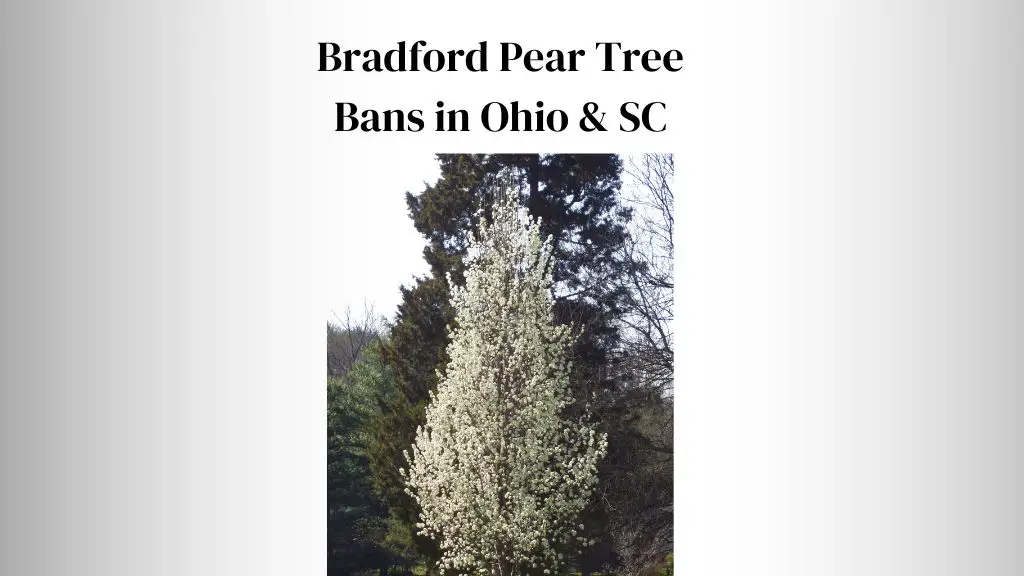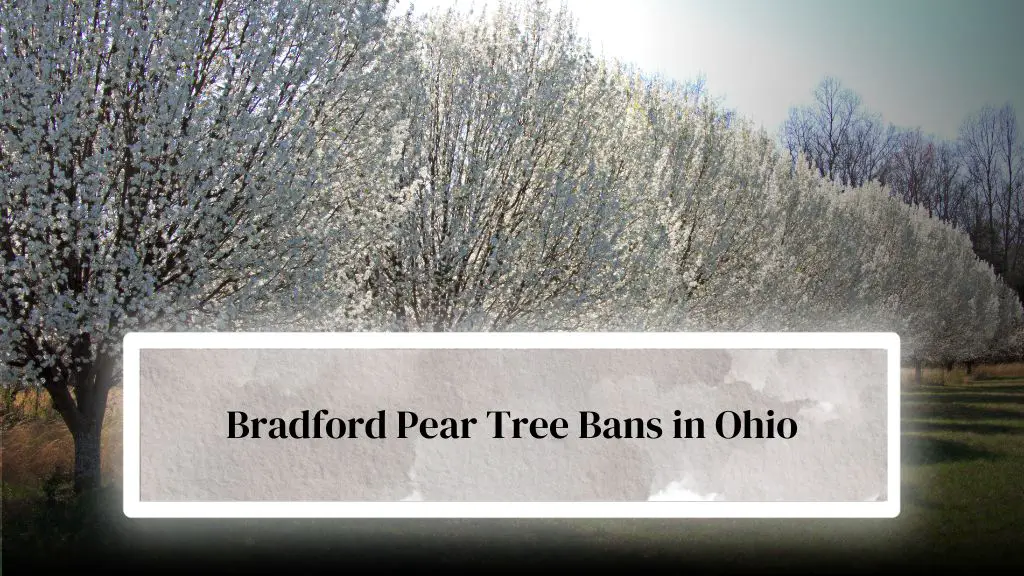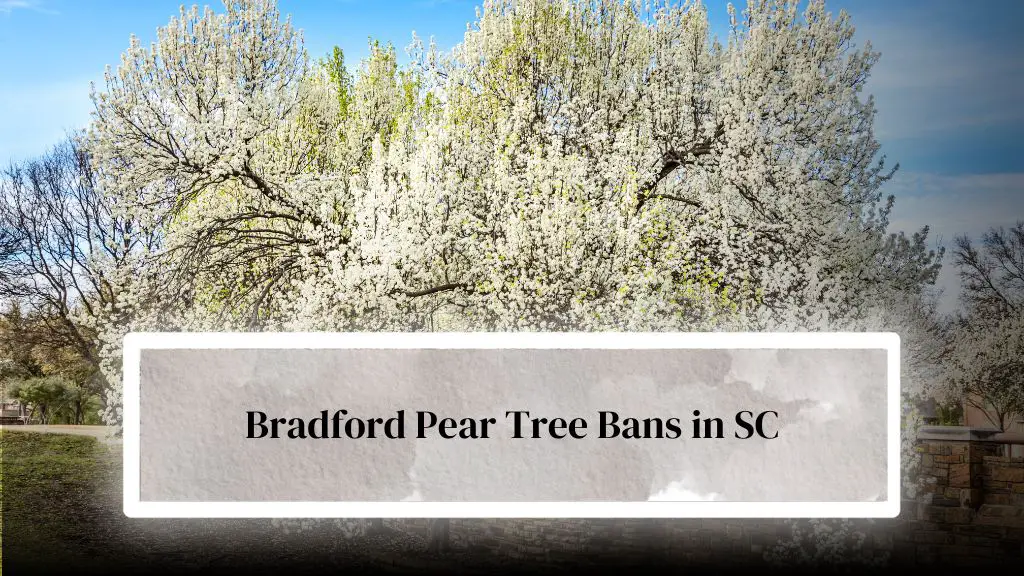
Do you know many states have banned planting Bradford pear trees due to their invasive nature? I’m particular; these bans are designed to prevent the spread of this specimen and protect native species from being overrun.
However, their ornamental value made Bradford pear trees popular in the United States in the 1960s and 1970s. So you may wonder, ‘Why Bradford Pear Trees are Being Banned.’ Did you know about Bradford Pear Tree Bans in Ohio & Bradford Pear Tree Bans in SC that shocked many people? However, keep reading if you want to learn about States That Ban Bradford Pear Trees.
Bradford Pear Tree Bans in Ohio

Ohio is one state that has banned the planting of Bradford pear trees. If you live in Ohio, you should know that the Ohio Department of Natural Resources has classified the trees as invasive and recommends that they not be planted. But, Is Bradford Pear Tree Banned in Ohio? Here’s what you need to know.
Is Bradford Pear Tree Banned in Ohio?
Yes, the planting of Bradford pear trees is banned in Ohio. It would be best if you never tried to grow this specimen in your landscape to preThe state recommends that residents plant native trees instead.
5 Reasons Why Are Bradford Pear Trees Banned In Ohio
- Invasive Nature: As I said z Bradford pear trees are known for their invasive nature. They can spread quickly and take over natural areas of your landscape, crowding out native species.
- Weak Wood: Bradford pear trees also come with weak wood that can break easily in strong winds or heavy snow. If you live in such areas, avoid this specimen because this can also lead to property damage and safety hazards. I”ve covered an entire topic or “Is Bradford Pear a Hardwood?“.
- Short Lifespan: Weak wood and Bradford pear trees have a relatively short lifespan compared to other trees. They typically only live for 20 to 25 years, so you must replace them frequently.
- Disease-prone: Bradford pear trees are susceptible to several diseases, including fire blight & pear trellis rust. This can make them difficult for you to maintain, which may also spread disease to other trees of your landscape.
- Invasive Fruit: Since Bradford pear trees produce large quantities of fruit, it is often spread by birds and other animals, which indirectly leads to the spread of the Bradford pear tree into natural areas. If you are wondering.”Is Bradford Pear Tree Fruit Edible” check this article out.
Also Read: Is bradford pear good firewood?
3 Effects of Bradford Pear Tree Ban in Ohio
- Protection Of Native Species: By banning the planting of Bradford pear trees, Ohio is helping to protect its native species from being overrun by these invasive trees.
- Increased Awareness: Believe me, very few people knew about the invasiveness of the Bradford pear tree in the past. The ban has raised awareness about the negative impact of invasive species on the environment. This has also led to a greater emphasis on planting native species. If you’re wonder “ Are Bradford Pear Trees Bad For The Environment?, you’re not alone; read 7 Reasons Why.)
- Alternative Tree Options: The ban has encouraged Ohio residents to consider alternative tree options better suited to the local environment.
Bradford Pear Tree Bans in South Carolina

Unlike Ohio, South Carolina has no statewide ban on Bradford pear trees. Several cities and counties have implemented bans. According to the South Carolina Forestry Commission, a few of the cities and counties include:
- Charleston
- Columbia
- Greenville
- Myrtle Beach
- Spartanburg
- Richland County
- Berkeley County
- Dorchester County
- Lexington County
Why Bradford Pear Tree Ban In Sc
Well, the reasons for the Bradford pear tree ban in South Carolina are very similar to those in other states; these trees are invasive & harm native ecosystems. They also pose a safety hazard due to their tendency to split & break.
Effects of Bradford Pear Tree Ban in South Carolina
During the ban, the state has also been met with some resistance from homeowners and landscapers who value the trees for their aesthetic appeal. However, the ban on Bradford pear trees in South Carolina has helped to protect native ecosystems & promote the growth of native plants.
Not only in Ohio or South Carolina but Bradford pear trees have also been banned in several other countries worldwide. However, like in the United States, these bans have also caused controversy among those who value trees for their aesthetic appeal.
The main justifications for the state prohibitions are the Bradford pear tree’s invasiveness & harmful effects on the surrounding ecosystem. These trees undoubtedly invade the area and outcompete the natural vegetation with their rapid & aggressive growth.
They also pose a safety risk in storms & strong winds because they are also prone to splitting & breaking. Bans on Bradford pear trees imposed by the state have helped stop the spread of invasive species & promoting the development of native species.
Homeowners and landscapers who might still want to plant the trees for their aesthetic value have continuously expressed their feelings & opposition to these bans. According to the Global Invasive Species Database, these countries banned Bradford pear trees :
- Australia
- New Zealand
- South Africa
- Canada
- Some Parts Of the United States
7 States That Ban Bradford Pear Trees
Several states in the United States have banned the planting of Bradford pear trees due to their invasive nature and negative environmental impacts. According to the United States Department of Agriculture (USDA), these states include:
- Kentucky
- Maryland
- New York
- Ohio
- Pennsylvania
- Virginia
- West Virginia
Negative Impacts of Bradford Pear Trees
There are various negative effects of Bradford pear trees on our environment. They not only displace natural plants but also lowers biodiversity & change ecosystems.
Additionally, Bradford pear trees are known to emit a potent odor that may be unpleasant. Also, they come with weak wood that is more likely to break during storms & strong winds, creating a safety hazard for the surrounding structures.
Alternatives to Bradford Pear Trees
You can choose from various options besides Bradford pear trees. I’ll recommend you go with Native trees like dogwoods, redbuds, and magnolias because they not only provide a comparable aesthetic appeal but also avoid negatively affecting the ecosystem.
Alternatively, you can plant Non-native trees like the Japanese cherry blossom and the crape myrtle.
Conclusion
I hope you understand why many states have banned these native invasive species from being grown in their areas, as they not only have negative effects on the ecosystem but also create problems like safety hazards. We must safeguard our local ecology and encourage the development of native flowers.
Many nations and governments are trying to restrict the planting of these trees in place. Suppose you’re one of the people who value Bradford pear trees for their aesthetic value and oppose these bans. In that case, many other options can offer a similar level of beauty without the negative effects on your landscape.
I usually like to plant Dogwoods, as they are native trees with a similar visual appeal without hurting the ecosystem. I hope you find this article helpful where. I have tried my best to give you all the information about the Bradford pear tree bans in Ohio & Bradford pear tree bans in South Carolina.
If you find this article helpful, then consider sharing. Your share will help people learn about states that ban not only Bradford pear trees but also the negative impact & the alternative of this specimen. Do check our other helpful guide on Bradford pear tree care & management. See you in the next post; till then, take care & goodbye.
